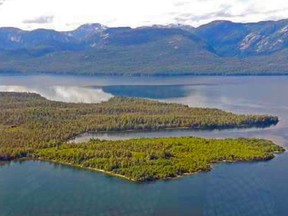
The head of Enbridge calls it a second chance, while Alberta’s premier sees the U.S. moratorium on approving LNG export projects as an opportunity for Canada to “catch up.”
“I hope we don’t blow it,” Danielle Smith told reporters Thursday during a news conference in Washington, D.C.
“I hope if the Americans are going to take a pause, that we use this as an opportunity to accelerate some of those (Canadian) projects.”
Smith made the comments during her first trip as premier to the U.S. capital, less than two weeks after the Biden administration put a temporary halt on approving licences for new liquefied natural gas export developments.
Alberta wants to see speedy progress made on Canadian projects that would export super-chilled natural gas — as well as ammonia — to customers in Asia.
While Canada has failed to complete any LNG projects over the past decade, the U.S. has become the world’s largest exporter. However, there are signs this country is about to take some big steps forward this year with projects on the B.C. coast.
Construction on the Shell-led LNG Canada project is entering the home stretch, while its partners also consider a potential expansion.
-
 Protectionist policy promises in U.S. election will be a challenge: Smith
Protectionist policy promises in U.S. election will be a challenge: Smith -
 Varcoe: U.S. pause on LNG projects offers Canada ‘second chance’ to be global player, says Enbridge CEO
Varcoe: U.S. pause on LNG projects offers Canada ‘second chance’ to be global player, says Enbridge CEO -
 White House hits pause on U.S. LNG approvals, rattling Canadian energy producers
White House hits pause on U.S. LNG approvals, rattling Canadian energy producers -
 Varcoe: ‘Still plenty of room for Canada to be a serious player’ in global LNG race, says Enbridge head
Varcoe: ‘Still plenty of room for Canada to be a serious player’ in global LNG race, says Enbridge head
During a call with analysts last week, Shell CEO Wael Sawan said the commissioning phase is expected to start up later this year. It will take several months and extend “well into 2025, but it is comforting to see the progress.”
The Woodfibre LNG development is also being built, while a final investment decision on Cedar LNG is expected in the first quarter. The Ksi Lisims proposed project is also gaining momentum.
Building more LNG export terminals in British Columbia will increase the province’s and Canada’s greenhouse gas emissions. Such projects will be included in the new federal emissions cap on the sector.
But Karen Ogen, chief of the First Nations LNG Alliance, said Canadian projects can displace the use of coal in other countries and reduce global emissions, as well as support economic reconciliation.
“This is a window of opportunity for not only B.C., Canada and Indigenous people, (but) for the countries that need our LNG. I can’t emphasize that enough,” Ogen said Thursday.
In late January, the Biden administration placed a temporary pause on approving LNG exports, affecting new projects, as it examines their impact on the environment, energy security and the economy.
The U.S. became the largest LNG exporter in the world last year, eclipsing Qatar and Australia, and is capable of exporting 14 billion cubic feet (bcf) per day. Four other facilities are under construction.
Greg Ebel, CEO of Enbridge — a partner with Pacific Energy Corp. on the Woodfibre development — said last week the U.S. pause could give Canada a “second chance” to develop its industry.
According to energy consultancy Wood Mackenzie, U.S. LNG export capacity is forecast to double by the end of the decade, accounting for 30 per cent of global supply. It believes a wait of up to two years in investment into U.S. projects could be absorbed by the global market, but longer delays would affect the LNG sector.
Wood Mackenzie analyst Dulles Wang said there could be an opportunity for LNG projects in Canada to move forward.
Yet, there are domestic issues to resolve, including the need for regulatory certainty in Canada, the high costs to build infrastructure — such as gas pipelines to move supplies to the coast — and the need for hydroelectric power to reduce emissions tied to LNG production.
“There has been a really strong impetus for buyers to look elsewhere outside of the U.S. given the regulatory uncertainty, which could be a boost for Canadian LNG projects, but we are our own worst enemy,” he said from Calgary.
“For Canadian projects, we’re also looking at regulatory uncertainty, especially around emissions reductions.”

During the news conference, Smith touted the integrated energy systems linking Canada and the United States.
When it comes to Canadian LNG and ammonia, which can be a hydrogen carrier, there is also strong interest from countries such as South Korea for Canadian product, she added.
“This is a real opportunity for us to assert that we can also be a secure supplier of LNG — and ammonia, quite frankly. That is another potential opportunity for us with Japan,” Smith said in an interview.
“Europe is (taking) measures to invest in natural gas because it is a lower-emitting fuel . . . In Canada, in particular, we’ve got to get our heads straight on that. Natural gas is a transition fuel.”
As for the U.S.-Canada energy relationship, it is massive, but not without its complexities.
These include the long-running dispute with the state of Michigan over Enbridge’s Line 5 pipeline, and the cancellation of cross-border permits for the Keystone XL pipeline by President Joe Biden.

The Alberta government lost $1.3 billion investing in the project, which was being built by TC Energy before it was nixed by the White House in 2021. The Calgary-based pipeline giant has started a NAFTA claim against the U.S., seeking to recover more than US$15 billion in damages.
Smith said she raised the issue during her trip to Washington, which has included visits with several senators, including Marsha Blackburn of Tennessee, Markwayne Mullin of Oklahoma and Rand Paul of Kentucky.
“I don’t like fighting with our American friends. I would rather that we come to some agreement so we would be able to withdraw that challenge,” the premier said.
“We were gravely disappointed. I think we’d be having a very different conversation about both of our security interests if Keystone was well underway.”
Chris Varcoe is a Calgary Herald columnist.
You can read more of the news on source




